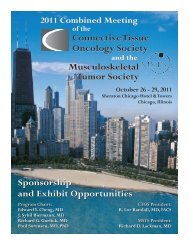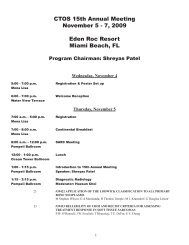207 Poster Session 2 - Connective Tissue Oncology Society
207 Poster Session 2 - Connective Tissue Oncology Society
207 Poster Session 2 - Connective Tissue Oncology Society
Create successful ePaper yourself
Turn your PDF publications into a flip-book with our unique Google optimized e-Paper software.
Scientific <strong>Poster</strong>s – <strong>Poster</strong> <strong>Session</strong> 2No 17 (81%) 25 (68%)Yes 4 (19%) 12 (32%)Association between the intRAmuscular location and localrecurrence-free survival in soft tissue sarcoma. Patients in theintRA-muscular group showed significantly better localrecurrence-free survival than those in the intER-musculargroup (p=0.021).<strong>Poster</strong> #183CAUSE AND EFFECT OF LOCAL RECURRENCEIN EXTREMITY SOFT TISSUE SARCOMA -ARE WE MAKING A DIFFERENCE?Vignesh K. Alamanda 1 ; Samuel N. Crosby 1 ;Kristin R. Archer 1 ; Yanna Song 2 ; Jennifer L. Halpern 1 ;Herbert S. Schwartz 1 ; Ginger E. Holt 11Department of Orthopaedics and Rehabilitation, VanderbiltUniversity Medical Center, Nashville, TN, USA;2Department of Biostatistics, Vanderbilt University MedicalCenter, Nashville, TN, USAObjective: Limb salvage surgery (LSS) has gained widespreadacceptance as the current treatment for treatingextremity soft tissue sarcoma (STS) and has been greatlyrefined since its inception. Combined with improvedadjuvant treatment modalities, rates of local relapse havegreatly decreased. Nonetheless, local recurrence still occursand identifying the cause and the subsequent effectsof local recurrence in this age of LSS can provide insightsas LSS has continued to evolve.Methods: This retrospective study evaluated 278 patientstreated for STS of the extremities between 2000- 2006.Primarily excised STS (n=172), incompletely excised specimens(n=106) with residual disease (n=29) and without(n=77), were all assessed for margin status, local recurrence,and overall survival. Patients with a local recurrence(n=41) were compared with those without (n=247) to assessdifferences in subsequent prognosis. Wilcoxon rank sumtest was used to compare continuous variables and eitherχ¬2 or Fisher's exact was used to compare categoricalvariables. Kaplan Meier and Gray’s test for cumulativerisk were performed between those with recurrence andthose without.Results: Positive margins were the single strongest predictorof local recurrence following primary or re-excision inextremity soft tissue sarcoma. (p = 0.0000011) In patientswho underwent a re-excision, the presence or absence ofresidual disease upon re-excision did not have any bearingon local recurrence. (p=0.27) In comparing patientswith and without local recurrence, there was no statisticallysignificant difference in the rate and the proportionencountering distant metastasis and death due to sarcoma.(p = 0.44 and 0.09 respectively).Conclusion: Despite advancements in surgery, radiation,and imaging, positive margins still occur, and the presenceof positive margins following definitive treatment continuesto remain as a strong predictor for local recurrence.While local recurrence represents a negative outcome fora patient, its impact on future prognosis is influenced bya variety of factors such as time to local recurrence as wellas the tumor’s inherent biological characteristics.265






